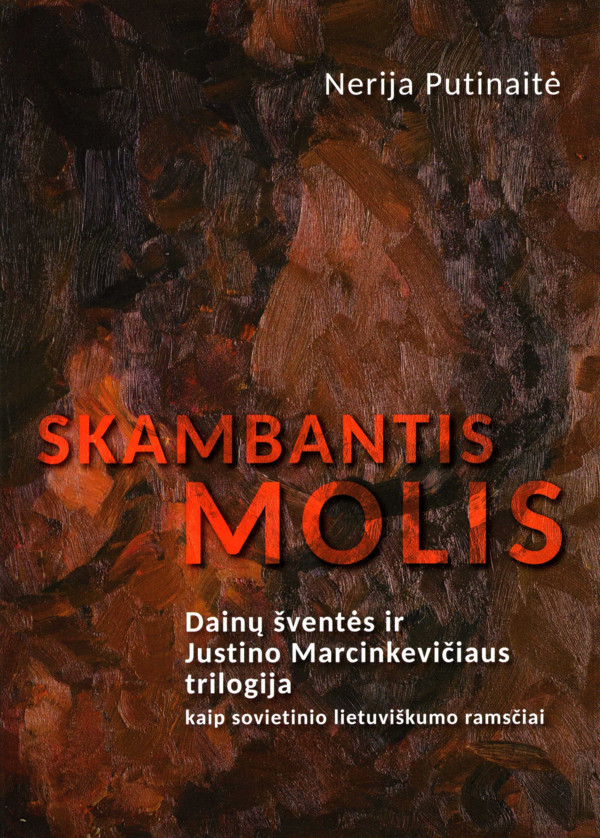
Original title: Skambantis molis: dainų šventės ir Justino Marcinkevičiaus trilogija kaip sovietinio lietuviškumo ramsčiai
Publishing date: 2019
Publisher: Lietuvių katalikų mokslo akademija, Naujasis židinys-Aidai
Language: Lithuanian
Pages: 408
Description:
The book analyzes the cultural Soviet nationalism in the Lithuanian SSR. It posits that during the Soviet era, the administrative and culture-creating means were applied to merge the national and the Soviet identity, in other words, nationalism and communism and to form a unique Soviet national identity. This is a way to avoid the occasionally occurring simplistic approach to Soviet nationalism wherein it is analyzed through the cultural opposition between the (antinationalist) internationalist policy and the (resisting) ethnic national identity. The efforts to develop the Soviet national identity were an expression of the pragmatic interest of the administration of the Lithuanian SSR to rule the national community, thus also legitimizing the ruling itself. It was rooted in the paradoxical relationship between the Soviet state and the nationalism of its nations. According to the letter of the Soviet dogma, in the state created by the proletariat, even if it was multinational, no national tensions could remain. The administration of the state had to be unaffected by the divisions among the national groups and national interests. In practice, the leaders of the state, as they centralized it, had to take into account the existence of nations and the national feelings. The Soviet state was formed from administrative territorial units based on ethnicities, and ethnic groups were guaranteed a certain autonomy of their language and culture. The pseudo-republics were allowed to develop certain national traits, as long as they did not cross the boundaries of the centralization goals. The administrative elites of the republics to a certain extent acted as “nationalists”, and that was caused by this national policy of the Soviet Union, which aimed for centralization but had to be based on national interests. The national elites aimed to rule their republics well, to overcome the society’s hostility towards the regime.The book does not analyze the political nationalism that was at odds with the political goals with the regime, and often was anti-regime, persecuted and destroyed. The analysis is limited only to the forms of administrative and cultural nationalism, their connection and distinction. The administrative elites that ruled the republics acted as administrative nationalists in that they aspired to a relative independence from the center (Moscow). They also developed various forms of cultural nationalism as one of the ways to connect the ethnically delineated society of the republic to its political elite. Such a connection was very much in the interests of the elite of the republics, because good relationships with the societies made the administration of the republics easier, the political position of the elites stronger in the eyes of the central government, the directives of the central government more easily enacted, as well as providing a symbolic foundation to their legitimacy. The sovietized identity with some national traits also at least partly corresponded to the national expectations of the society. The cultural national identity forged out of the national tradition and the Soviet meanings was recognized by the society and provided the conditions for the society, its groups or individuals to attach communal meanings to it. The book is an attempt to show the specificity and functions of the Soviet Lithuanian cultural nationalism. It tries to answer the questions about what nation, ethnic identity and Lithuanian in particular and national in general self-consciousness was created by the cultural nationalism, what were its attributes and elements.It attempts to reveal how the new national self-consciousness was formed, what were its traits, what were the limits of the cultural nationalism, how they were defined, which expressions of the cultural nationalism were encouraged and which repressed; what emotions related to the national identity were established by the cultural nationalism; in what ways the cultural nationalism helped legitimize the Soviet government in Lithuania, strengthen the administrative nationalism and the aspirations of autonomy of the leadership of the Lithuanian SSR; how the distinctions between the cultural and the political nationalism were defined. The object of the analysis is two prominent phenomena of the Lithuanian nationalism: the song festivals and the trilogy of plays by Justinas Marcinkevicius (1930-2011). The first Soviet Lithuanian song festival took place in 1946, when the Lithuanian administration was going through a crisis of legitimacy. The song festivals were organized regularly up until the end of the Soviet era. Marcinkevicius published his trilogy (Mindaugas, Mazvydas and Katedra [The Cathedral]) in 1968-1977, in response to the Lithuanian national self-consciousness and condition of the post-Khrushchev era. Both phenomena deeply affected the Lithuanian national identity during the Soviet time and, to an extent, are still affecting it today. The analysis employs various contextual sources that help understand these phenomena: archival materials, literature of the time, work of the present-day researchers. [Excerpt]
Cite as: Putinaitė N., (2019) Skambantis molis: dainų šventės ir Justino Marcinkevičiaus trilogija kaip sovietinio lietuviškumo ramsčiai. Vilnius: Lietuvių katalikų mokslo akademija, Naujasis židinys-Aidai.
Purchase here.







